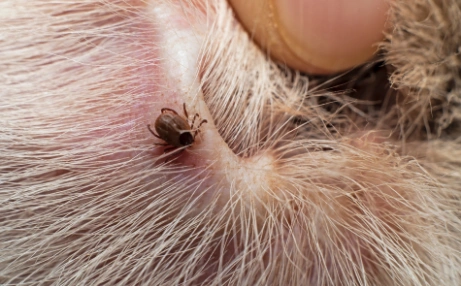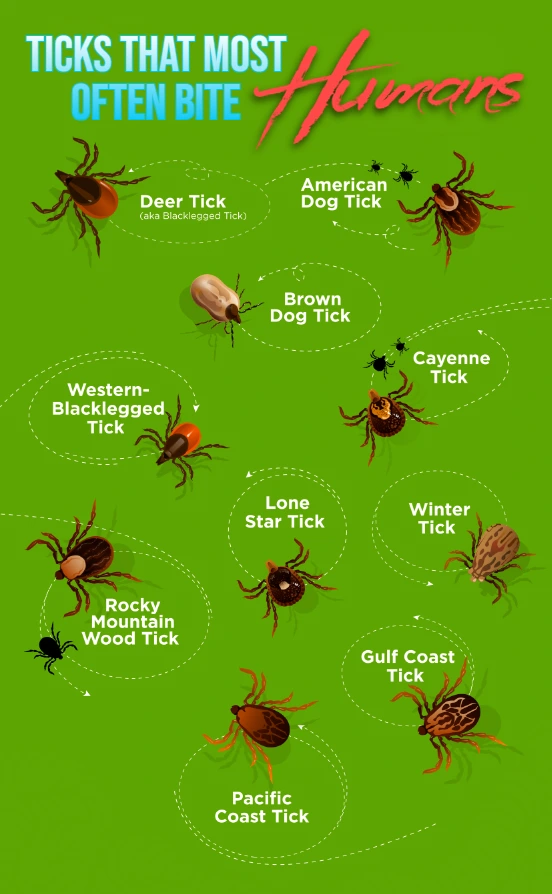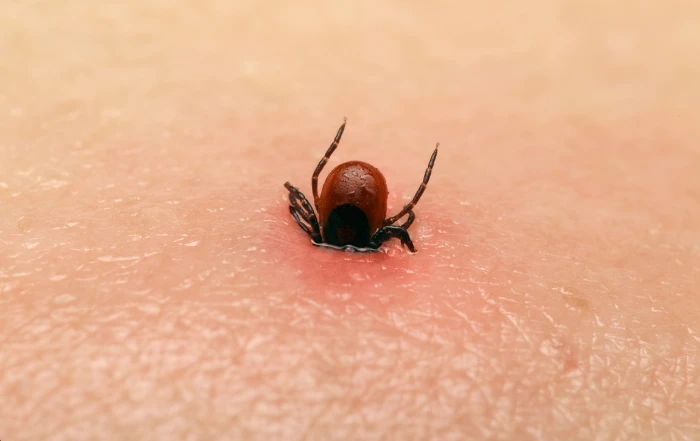Ticks can be a real nuisance, but with the right strategies, you can create a tick-free environment in your yard. Not only will this prevent annoying bites and rashes, but it will also reduce the risk of tick-borne diseases.
So, if you’re ready to enjoy the outdoors without worrying about ticks, here are six effective ways to keep them out of your yard and consequently, off of yourself and your pets.
1. Maintain a Well-Groomed Lawn
Ticks love to hide in long grasses, so keeping your grass short is a crucial step in tick prevention.
Regularly mow your lawn and maintain it at a height of around 2 ½ to 3 inches. Removing excess grass length reduces the areas where ticks can hide and latch onto you.
Additionally, be sure to rake up and remove dead leaves, as they can serve as hiding spots for ticks. Pruning overgrown bushes and trees will also help create a less appealing environment for these pests.

you can make it harder for a tick to find your dog's ear.
2. Create a Tick-Repelling Barrier
To deter ticks from entering your yard, consider creating a hostile barrier. Clear your yard of debris and place a thick layer of gravel or wood chips around the perimeter. Ticks dislike crossing paths lined with these materials, as they can hurt their delicate feet. Not only does this act as a natural deterrent, but it also adds an attractive decorative element to your backyard.
3. Manage Wood Piles
Wood piles provide ideal hiding spots for ticks, as well as mice and rats that can transport ticks into your yard. To minimize tick habitat, stack wood neatly in an area that receives sunlight. The exposure to sunlight will help dry out the wood, making it less appealing to ticks.
By properly managing your wood piles, you’ll eliminate potential hiding places for ticks and reduce the presence of other unwanted pests.

4. Embrace Natural Tick Repellents
If you prefer to avoid chemical repellents, natural alternatives can effectively repel ticks from your yard. Cedar oil spray and neem oil are known to suffocate, dehydrate, and disrupt pheromones of ticks, ultimately repelling or killing them. You can purchase these oils at local gardening centers or create a homemade solution.
For cedar oil spray, mix one to two teaspoons of cedarwood essential oil with one cup of water in a spray bottle. Apply the mixture to shaded areas and yard perimeters where ticks are likely to hide.
Similarly, mix two teaspoons of neem oil with four cups of water for a neem repellent spray. Diluted garlic oil and peppermint oil also serve as effective natural tick repellents due to their strong smells that repel ticks.
5. Utilize Diatomaceous Earth
Diatomaceous earth, a naturally occurring powder made from fossilized aquatic organisms called diatoms, is an excellent solution for killing ticks and other pests.
Its abrasive nature destroys the protective outer layer of ticks, causing them to dry out and die. Sprinkle diatomaceous earth around your yard, creating a line that is one to two inches thick, using a powder duster.
This barrier will prevent ticks from passing through, effectively protecting your lawn and plants.
6. Create a Tick-Free Zone
Designate a specific area in your yard as a tick-free zone where you can relax and enjoy outdoor activities without worrying about ticks. This could be a patio, deck, or a designated section of your lawn. Create a physical barrier to keep ticks away from this area by installing a fence or using landscaping features like gravel or mulch. Ensure the area is well-maintained, with no tall grasses or overgrown vegetation nearby.
By having a designated tick-free zone, you can enjoy your outdoor space with peace of mind, knowing that ticks are less likely to bother you in that specific area.
9 Interesting Things About Ticks
- Tick Superpowers: Ticks possess some remarkable abilities. They have a specialized sensory organ called Haller’s organ, which helps them detect hosts through changes in temperature, humidity, and carbon dioxide levels. Ticks can also survive for long periods without feeding, sometimes up to two years, depending on the species.
- Ancient Creatures: Ticks are ancient creatures that have been around for millions of years. Fossil evidence suggests that ticks existed during the Cretaceous period alongside dinosaurs. They have adapted and evolved over time to become successful parasites.
- Varied Species: There are over 900 species of ticks worldwide. These species vary in size, color, and habitat preferences. Some common species include the black-legged tick (also known as the deer tick), the American dog tick, and the lone star tick.
- Disease Carriers: Ticks are notorious for transmitting diseases to humans and animals. Lyme disease, caused by the bacterium Borrelia burgdorferi, is one of the most well-known tick-borne diseases. Other diseases transmitted by ticks include Rocky Mountain spotted fever, babesiosis, anaplasmosis, and tick-borne encephalitis.
- Efficient Bloodsuckers: Ticks are skilled bloodsuckers and have specialized mouthparts designed for feeding on hosts. They insert their mouthparts into the host’s skin and secrete substances that prevent blood clotting, allowing them to feed for extended periods.
- Tick Hitchhikers: Ticks often hitch a ride on animals to reach new hosts. They can attach themselves to birds, mammals, and even reptiles. This behavior helps ticks expand their range and find new opportunities for feeding.
- Slow Movers: Ticks are not the fastest creatures. They crawl rather than jump or fly, which is contrary to popular belief. Their slow movement combined with their ability to remain hidden makes it easier for them to latch onto passing hosts.
- Tick Life Cycle: Ticks have a complex life cycle that involves four stages: egg, larva, nymph, and adult. During each stage, they require a blood meal to progress to the next. Depending on the species, this life cycle can take several months to a few years to complete.
- Tick Host Preferences: Different tick species have specific preferences when it comes to hosts. While some ticks primarily target certain animal species, others are less selective and can feed on a wide range of hosts, including humans.
Remember, ticks are most active from April to September, so implementing these preventive measures before their peak season is crucial. By maintaining a well-groomed yard, creating barriers, using natural repellents, and incorporating diatomaceous earth, you can keep ticks at bay and enjoy your outdoor spaces without worry.
And always remember, tick prevention can be a serious matter, but it doesn’t mean you can’t have some fun in the process. So put on your tick-repellent cape and transform into a tick-battling superhero, safeguarding your yard from these tiny villains!



















